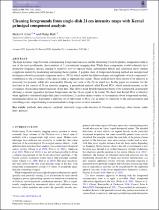| dc.contributor.author | Irfan, Melis O | |
| dc.contributor.author | Bull, Phillip | |
| dc.date.accessioned | 2022-06-15T13:33:30Z | |
| dc.date.available | 2022-06-15T13:33:30Z | |
| dc.date.issued | 2021 | |
| dc.identifier.citation | Irfan, M. O., & Bull, P. (2021). Cleaning foregrounds from single-dish 21 cm intensity maps with kernel principal component analysis. Monthly Notices of the Royal Astronomical Society, 508(3), 3551-3568. doi:10.1093/mnras/stab2855 | en_US |
| dc.identifier.issn | doi:10.1093/mnras/stab2855 | |
| dc.identifier.uri | http://hdl.handle.net/10566/7519 | |
| dc.description.abstract | he high dynamic range between contaminating foreground emission and the fluctuating 21 cm brightness temperature field is one of the most problematic characteristics of 21 cm intensity mapping data. While these components would ordinarily have distinctive frequency spectra, making it relatively easy to separate them, instrumental effects and calibration errors further complicate matters by modulating and mixing them together. A popular class of foreground cleaning method are unsupervised techniques related to principal component analysis (PCA), which exploit the different shapes and amplitudes of each component's contribution to the covariance of the data in order to segregate the signals. These methods have been shown to be effective at removing foregrounds, while also unavoidably filtering out some of the 21 cm signal too. In this paper we examine, for the first time in the context of 21 cm intensity mapping, a generalized method called Kernel PCA, which instead operates on the covariance of non-linear transformations of the data. This allows more flexible functional bases to be constructed, in principle allowing a cleaner separation between foregrounds and the 21 cm signal to be found. We show that Kernel PCA is effective when applied to simulated single-dish (auto-correlation) 21 cm data under a variety of assumptions about foregrounds models, instrumental effects etc. It presents a different set of behaviours to PCA, e.g. in terms of sensitivity to the data resolution and smoothing scale, outperforming it on intermediate to large scales in most scenarios. © 2021 The Author(s). | en_US |
| dc.language.iso | en | en_US |
| dc.publisher | Oxford University Press | en_US |
| dc.subject | Cosmology: observation | en_US |
| dc.subject | Large-scale structure of Universe | en_US |
| dc.subject | Methods: data analysis | en_US |
| dc.subject | Radio lines: galaxies | en_US |
| dc.title | Cleaning foregrounds from single-dish 21 cm intensity maps with Kernel principal component analysis | en_US |
| dc.type | Article | en_US |

